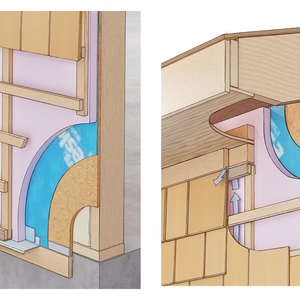Best way of forming concrete stairs?
Discussion Forum
Discussion Forum
Up Next
Video Shorts
Featured Story

There are some instances where multiple minisplits make sense.
Featured Video
Video: Build a Fireplace, Brick by BrickHighlights
"I have learned so much thanks to the searchable articles on the FHB website. I can confidently say that I expect to be a life-long subscriber." - M.K.
Fine Homebuilding Magazine
- Home Group
- Antique Trader
- Arts & Crafts Homes
- Bank Note Reporter
- Cabin Life
- Cuisine at Home
- Fine Gardening
- Fine Woodworking
- Green Building Advisor
- Garden Gate
- Horticulture
- Keep Craft Alive
- Log Home Living
- Military Trader/Vehicles
- Numismatic News
- Numismaster
- Old Cars Weekly
- Old House Journal
- Period Homes
- Popular Woodworking
- Script
- ShopNotes
- Sports Collectors Digest
- Threads
- Timber Home Living
- Traditional Building
- Woodsmith
- World Coin News
- Writer's Digest


















Replies
with wood
Wood is Good
Adam Greisz
Sorry this is my first time.
I did use wood. I mounted 2 x 4 stringers above treads. Then used 3/4 cleats to hang my risers. Any suggestions?
In addition, the existing landing had a bullnose. I split 1 1/2 pvc to create nose and nailed it to the 2x riser. Any suggestions?
Taper the bottom of riser to allow finishing back to face of concrete. I typically use a 45 degree bevel. I also use 2x10's or 12's and cut reverse stringers every 24" or so.
I use plywood at the sides and screw into the endgrain of the riser. I try to use screws to allow for easier disassembly (particularly on exposed aggregate finish). The concrete puts a lot of stress on the lower parts of these stringers and they must be heavily braced. If these braces are in the slab underneath the stairs let the mud start to set before removing them, then fill in the holes with some extra mud.
I use a grid of steel under the risers and drop a bar in each step during the pour. Hope this helps.
Wood is Good
Adam Greisz<!----><!----><!---->
<!----><!---->
>> I use a grid of steel under the risers << Mind expanding on that little bit? Do you mean a grid of steel under the entire assembly?
We usually use a grid of #4 bar 18" o.c. (sometimes called out on engineered plans). This is placed about 3" under the inside intersection of the tread and riser (bottom of each riser) running at the angle of the stairs.
Wood is Good
Adam Greisz<!----><!----><!---->
<!----><!---->
Edited 11/12/2005 11:17 am ET by AdamGreisz
I have done numerous stair forms , both curved and straight, and think one of the most important details is to allow for positive slope in the forming of each tread.
I allow 1/4" minimum, and up to 3/8" slope from back to front on each tread.
reasons being:
- trowel work at back of tread usually pushes concrete down.
- maintains good drainage to minimize rain and or ice build-up
Thanks long one for pointing out a very important fact. Having water, frost or ice on concrete steps can be dangerous.
Wood is Good
Adam Greisz<!----><!----><!---->
<!----><!---->
very important detail - you beat me to it
Thanks for the input. I did install a 12 X 12 grid and doweled into the existing wall for the nose bars. How about the bullnose?
You don't mention if these are closed or open stairs, exposed soffit or on grade. The techniques vary a little, but inverted stringers as Adam mentioned will make for a consistent and strong form. Ditto for ripping a 45° bevel on each riser form.
If you have concrete walls on either side of the new stairs, then all you need do is cut the risers about 1/8" short and shim them in using feather wedges. Mark the layout on the walls and then adjust the wedges until each riser is in exactly the right place. Pound the wedges in tight and you'll find they will support a man walking on them. Finally use silicone to seal the gaps around the shims and you'll get a nice clean finished joint. If the staircase are wider than 36" or so, fasten an inverted stringer down the centreline of the stairs to prevent the risers from bowing.
When the concrete comes, make sure they don't water it. Ask for 3" slump (very stiff) when you order. Start placing at the bottom of the stairs, making sure to fully vibrate each one as you go up. Yes there will be some slumping as the concrete comes up over the top of the riser form, but you must get good consolidation or there will be ugly honeycomb for you to look for years to come. Level each riser off, and make sure to run your float right throught o the exact bottom edge of the riser above.
Take your time when finishing concrete stairs. They are one of the more difficult things in the concrete finisher's repertoire. I prefer to leave them out when pouring slabs, as all too often the stairs get overlooked during the hustle of placing and finishing a big slab. Then they get rushed and look like hell. Not many people look at a floor, but they sure as hell look at stairs every time they use them, so it's worth getting them right. I recommend doing stairs in a separate pour if possible.
Thanks for the advice. They are closed by existing walls. Next time I,ll try the shims. How about the bullnose?
Sounds good, just make sure it will strip out without breaking the edge off. It will give a different surface look, very smooth next to the wood grain look of the risers. I'd avoid stripping the bullnose as long as possible, let the conc gain max strength and then go very carefully. Maybe set circ saw very shallow and cut along length of pipe to score it then break it off that way.Lignum est bonum.